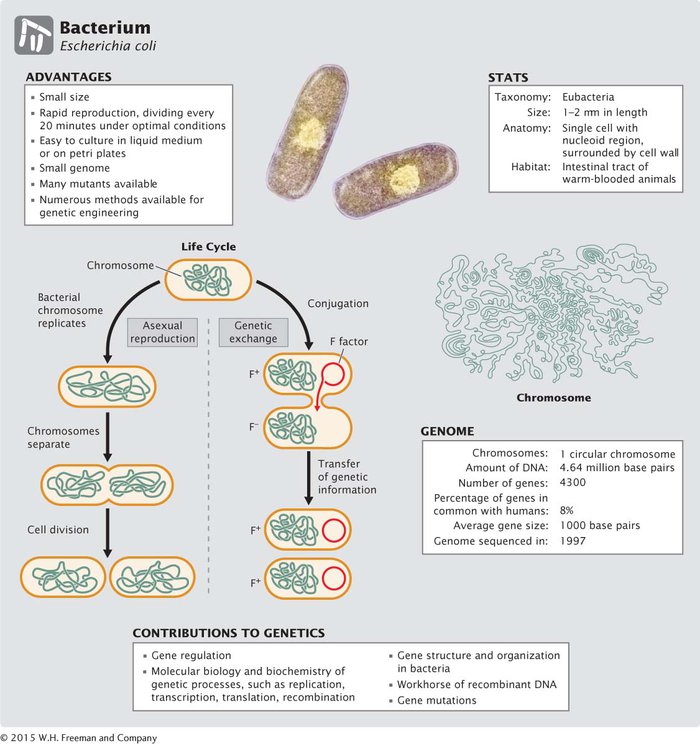Model Genetic Organism
The Bacterium Escherichia coli
 The most widely studied prokaryotic organism, and one of the best genetically characterized of all species, is the bacterium Escherichia coli (Figure 7.18). Although some strains of E. coli are toxic and cause disease, most are benign and reside naturally in the intestinal tracts of humans and other warm-
The most widely studied prokaryotic organism, and one of the best genetically characterized of all species, is the bacterium Escherichia coli (Figure 7.18). Although some strains of E. coli are toxic and cause disease, most are benign and reside naturally in the intestinal tracts of humans and other warm-

Advantages of E. coli as a model genetic organism
Escherichia coli is one of the true workhorses of genetics: its twofold advantage is rapid reproduction and small size. Under optimal conditions, this organism can reproduce every 20 minutes; in a mere 7 hours, a single bacterial cell can give rise to more than 2 million descendants. One of the values of rapid reproduction is that enormous numbers of cells can be grown quickly, and so even very rare mutations will appear in a short period. Consequently, numerous mutations in E. coli, affecting everything from colony appearance to drug resistance, have been isolated and characterized.
Escherichia coli is easy to culture in the laboratory in liquid medium (see Figure 7.1a) or on solid medium in petri plates (see Figure 7.1b). In liquid culture, E. coli cells can grow to a concentration of a billion cells per milliliter, and trillions of bacterial cells can be easily grown in a single flask. When E. coli cells are diluted and spread on the solid medium of a petri dish, individual bacteria reproduce asexually, giving rise to a concentrated clump of 10 million to 100 million genetically identical cells, called a colony. This colony formation makes it easy to isolate genetically pure strains of the bacteria.
The E. coli genome
The E. coli genome is on a single chromosome and—
The E. coli life cycle
Wild-
Genetic techniques with E. coli
Escherichia coli is used in a number of experimental systems in which fundamental genetic processes are studied in detail. For example, in vitro translation systems contain within a test tube all the components necessary to translate the genetic information of a messenger RNA into a polypeptide chain. Other similar systems allow transcription, replication, gene expression, and many other important genetic functions to be studied and analyzed under controlled laboratory conditions.
Escherichia coli is also used widely in genetic engineering (recombinant DNA technology; see Chapter 14). Plasmids have been isolated from E. coli and genetically modified to create effective vectors for transferring genes into bacterial and eukaryotic cells. Often, new genetic constructs (DNA sequences created in the laboratory) are assembled and cloned in E. coli before transfer to other organisms. Methods have been developed to introduce specific mutations into E. coli genes, so genetic analysis no longer depends on the isolation of randomly occurring mutations. New DNA sequences produced by recombinant DNA technology can be introduced by transformation into special strains of E. coli that are particularly efficient (competent) at taking up DNA.
Because of its powerful advantages as a model genetic organism, E. coli has played a leading role in many fundamental discoveries in genetics, including elucidation of the genetic code, probing the nature of replication, and working out the basic mechanisms of gene regulation. 